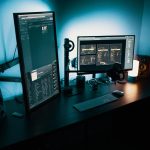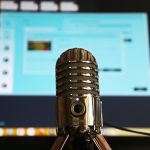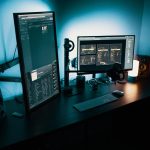Want to master working with a no sound monitor? Just like a skilled artist paints without hearing the brush strokes, you can work efficiently without sound.
By optimizing your visual workspace, utilizing text-based tools, and implementing visual cues, you'll navigate your tasks with ease. This guide will equip you with the strategies to excel in a soundless environment, enabling you to maximize productivity and focus.
Let's dive in and unlock the art of working efficiently with a no sound monitor.
Key Takeaways
- Adjust visual display settings for clear visibility and accurate representation of visuals
- Utilize text-based communication tools with clear language and visual cues for effective communication
- Organize workspaces for efficiency by maximizing desk space, using organizers, and minimizing distractions
- Implement visual timers, alerts, and task management techniques to enhance productivity and time management
Adjusting Visual Display Settings
How can you enhance your visual display settings for optimal efficiency when working with a no sound monitor? Customizing fonts, adjusting contrast, screen resolution, and color calibration are key elements to consider.
Begin by customizing fonts to ensure clear and comfortable visibility. Choose a font style and size that best suits your preference and promotes readability.
Next, adjust the contrast to achieve a balanced and vivid display. This will prevent eyestrain and ensure that content is easily discernible.
Additionally, optimizing the screen resolution is crucial for sharp and detailed imagery. Adjust the resolution to suit your workflow, ensuring that it enhances rather than hinders productivity.
Finally, color calibration is essential for accurate representation of visuals. Calibrating colors ensures consistency and precision, which is particularly important for design and image-related tasks.
Utilizing Text-Based Communication Tools
You can maximize productivity by integrating text-based communication tools into your workflow. These tools not only enhance accessibility features but also promote efficient collaboration and communication. Here are some strategies and tools to consider integrating:
| Visual Communication Strategies | Accessibility Features |
|---|---|
| Use clear and concise language | Ensure compatibility with screen readers |
| Incorporate bullet points and numbered lists | Utilize high contrast colors for text readability |
| Implement emojis and symbols for visual cues | Provide keyboard shortcuts for navigation |
When selecting text-based collaboration tools, it's essential to prioritize screen reader compatibility and seamless integration with accessibility features. Platforms that offer real-time editing, commenting, and version history can significantly enhance collaborative workflows. Additionally, features such as tagging, threaded conversations, and keyboard shortcuts can further streamline communication and productivity.
Organizing Workspaces for Efficiency
To optimize your workflow efficiency with a no sound monitor, consider arranging your workspaces to minimize distractions and maximize accessibility.
Start by maximizing desk space. Keep only the essentials on your desk, such as your computer, keyboard, mouse, and a notebook. Use organizers or containers to store pens, files, and other items that can clutter your workspace. This will help you focus on the task at hand without unnecessary items getting in the way. Additionally, consider using wall-mounted shelves or vertical desk organizers to free up even more space.
Next, focus on minimizing distractions. Position your desk in a quiet area away from high-traffic zones. If possible, use a room divider or noise-canceling headphones to create a quiet, focused environment. Keep your desk clean and clutter-free to avoid visual distractions. Use cable management tools to keep cords and wires out of sight and prevent them from becoming a distraction.
Implementing Visual Timers and Alerts
Implement visual timers and alerts to help you stay focused and track your work progress efficiently with a no sound monitor. Visual reminders play a crucial role in enhancing productivity and time management.
When working with a no sound monitor, it's important to rely on visual cues to manage your tasks effectively. Use visual timers to allocate specific time slots for different tasks. This will help you stay organized and ensure that you devote the right amount of time to each task.
Visual alerts can notify you when it's time to transition to a new task or take a break. These alerts can be in the form of pop-up notifications or color changes on your screen. By implementing visual timers and alerts, you can maintain a structured workflow and avoid distractions.
It's essential to customize these visual cues according to your preferences and work style. Experiment with different visual timer and alert tools to find the ones that work best for you.
Ultimately, visual timers and alerts can significantly improve your productivity and time management when working with a no sound monitor.
Leveraging Visual Task Management Techniques
Leveraging visual task management techniques involves prioritizing and organizing your work efficiently without relying on auditory cues. Visual Kanban boards and color-coded task lists are powerful tools to help you manage your tasks effectively.
| Visual Kanban Boards | Color-Coded Task Lists |
|---|---|
| Visual representation of tasks and their status | Tasks categorized by priority or type using different colors |
| Columns for different stages of work such as to-do, in progress, and done | Easy identification of urgent tasks and deadlines |
| Ability to see the flow of work and identify bottlenecks | Quick visual reference for task categories |
| Encourages team collaboration and transparency | Facilitates quick decision-making |
| Helps in managing work in progress limits | Enhances overall task management efficiency |
Optimizing Browser Tabs and Visual Bookmarks
You can efficiently manage your browser tabs and visual bookmarks to enhance your productivity and work efficiency even without auditory cues.
By organizing and prioritizing your web resources using visual cues and easy access, you can maintain focus and optimize your workflow.
Maximizing productivity in a no sound environment involves reducing distractions and utilizing visual aids effectively.
Start by streamlining your browser tabs and visual bookmarks to eliminate clutter and make it easier to locate essential resources. Use browser extensions or features that allow you to group tabs and save them for later access, keeping your workspace tidy and uncluttered.
Visual bookmarks, such as speed dial or bookmark bar, can serve as visual cues to quickly access frequently visited websites. Arrange them according to priority or frequency of use to optimize your browsing experience.
Additionally, consider using browser add-ons that provide thumbnail previews of tabs or visual bookmarks, allowing you to identify and switch between web resources more efficiently.
Frequently Asked Questions
What Are Some Tips for Effectively Communicating With Colleagues Who May Not Be Aware of Your Use of a No Sound Monitor?
To ensure effective communication at work, it's important to inform colleagues about your use of a no sound monitor. Being transparent about workplace accommodations can help everyone understand and respect your needs.
How Can I Ensure That I Am Not Missing Important Notifications or Alerts While Using a No Sound Monitor?
To ensure you're not missing important notifications or alerts while using a no sound monitor, utilize visual alerts and effective notification management. Stay aware of remote communication and maintain non-auditory awareness for efficient work.
Are There Any Specific Techniques for Managing and Prioritizing Tasks Visually When Using a No Sound Monitor?
When working with a no sound monitor, managing distractions and visual task management are crucial. Use color-coded labels, prioritize tasks with visual cues, and set up a visual timer to stay on track and efficiently manage your workload.
What Are Some Strategies for Avoiding Visual Fatigue or Eye Strain When Working With a No Sound Monitor for Extended Periods of Time?
To avoid eye strain when working with a no sound monitor for extended periods, adjust screen brightness, use blue light filters, and take regular breaks. These strategies can help reduce visual fatigue and keep your eyes healthy.
Can You Provide Any Recommendations for Software or Tools That Are Particularly Useful for Individuals Working With a No Sound Monitor?
When working with a no sound monitor, consider software recommendations that include accessibility features to enhance your productivity. Look for tools with visual cues, customizable color schemes, and text-to-speech functionality to accommodate your needs effectively.





